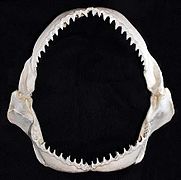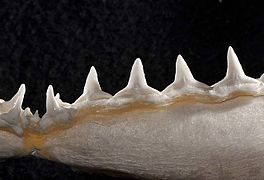Silvertip shark
| Silvertip shark | |
|---|---|

| |
| Scientific classification | |
| Domain: | Eukaryota |
| Kingdom: | Animalia |
| Phylum: | Chordata |
| Class: | Chondrichthyes |
| Subclass: | Elasmobranchii |
| Subdivision: | Selachimorpha |
| Order: | Carcharhiniformes |
| Family: | Carcharhinidae |
| Genus: | Carcharhinus |
| Species: | C. albimarginatus
|
| Binomial name | |
| Carcharhinus albimarginatus (
Rüppell , 1837) | |

| |
| Range of the silvertip shark | |
| Synonyms | |
|
Carcharias albimarginatus Rüppell, 1837 | |
The silvertip shark (Carcharhinus albimarginatus) is a large species of requiem shark, in the family Carcharhinidae, with a fragmented distribution throughout the tropical Indian and Pacific Oceans. It is often encountered around offshore islands and coral reefs, and has been known to dive to a depth of 800 m (2,600 ft). The silvertip shark resembles a larger and bulkier grey reef shark (C. amblyrhynchos), but can be easily identified by the prominent white margins on its fins. It attains a maximum length of 3 m (10 ft).
An aggressive, powerful
Taxonomy and phylogeny
The silvertip shark was originally described as Carcharias albimarginatus by German naturalist
Distribution and habitat
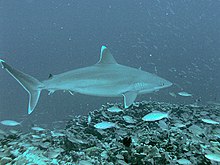
The silvertip shark is widely but not continuously distributed in the tropical Indian and Pacific Oceans. In the western Indian Ocean, this species occurs from the Red Sea to
Silvertip sharks are found over continental and insular shelves at a depth of 30–800 m (98–2,625 ft), occupying all levels of the water column. They are most common around isolated islands, coral banks, and reef drop-offs.[2][7] Juveniles frequent coastal shallows or lagoons, while adults occur in deeper water, with little overlap between the two age groups.[3][8]
Description
The silvertip shark is a robust and streamlined species with a moderately long, broad snout and large, round eyes. The five pairs of
The coloration is blue-gray above with a bronze sheen, and white below. A subtle white band runs along the sides, with distinctive white tips and borders on all fins. Silvertip sharks can grow up to 3 m (9.8 ft) long, but typically measure 2.0–2.5 m (6.6–8.2 ft) in length. The maximum reported weight is 162.2 kg (358 lb).[3] Females are larger than males.[8]
-
The silvertip shark can be recognized by its white-edged fins.
-
Jaws
-
Upper teeth
-
Lower teeth
Biology and ecology
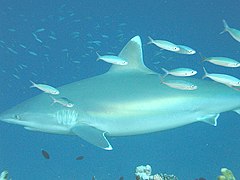
Though silvertip sharks are quite mobile, they exhibit fidelity to certain areas, with reports of
Like the grey reef shark, the silvertip shark sometimes perform a
Feeding
The diet of the silvertip shark consists primarily of
Life history
Like other requiem sharks, the silvertip shark is
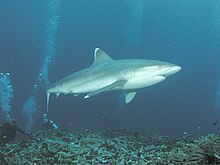
Human interactions
Inquisitive and bold, especially in the presence of food, the silvertip shark is regarded as potentially dangerous to humans. Often, several sharks will rush up from deep water to inspect divers when they first enter the water, which can be a very intimidating experience, as they may approach quite close.[18][19] This species has also been known to circle or pursue divers.[16] In one experiment involving bait, a large silvertip shark tore the leg off a dummy dressed in SCUBA gear, demonstrating that this species is capable of inflicting lethal injuries.[2] As of 2008, the International Shark Attack File listed four provoked attacks attributable to this species, none of them fatal.[20]
The silvertip shark is caught by commercial and
References
- ^ . Retrieved 11 November 2021.
- ^ ISBN 92-5-101384-5.
- ^ a b c Bester, Cathleen. Biological Profiles: Silvertip Shark, Florida Museum of Natural History Ichthyology Department. Retrieved on February 12, 2009.
- ^ Bray, Dianne J. (2011) Silvertip Shark, Carcharhinus albimarginatus (Rüppell 1837) Archived 2014-10-22 at the Wayback Machine, in Fishes of Australia
- ^ Garrick, J.A.F. (1982). Sharks of the genus Carcharhinus. NOAA Technical Report, NMFS CIRC-445.
- .
- ISBN 0-8248-1808-3.
- ^ ISBN 1-55209-629-7.
- ISBN 1-86825-394-5.
- S2CID 85954905.
- ^ a b Murch, A. Silvertip Shark. Elasmodiver.com. Retrieved on February 12, 2009.
- ISBN 0-8117-2875-7.
- ^ ISBN 1-900724-36-7.
- .
- ^ Martin, R.A. Agonistic Display in Grey Reef Shark. ReefQuest Centre for Shark Research. Retrieved on February 12, 2009.
- ^ ISBN 0-8047-2289-7.
- ^ Kato, S. & Hernandez Carvallo, A. (1967). "Shark tagging in the eastern Pacific Ocean, 1962–1965". In Gilbert, P.W.; Mathewson, R.F. & Rail, D.P. (eds.). Sharks, Skates, and Rays. Baltimore: The Johns Hopkins Press. pp. 93–109.
- ISBN 1-85974-239-4.
- ISBN 0-520-23917-2.
- ^ ISAF Statistics on Attacking Species of Shark. International Shark Attack File, Florida Museum of Natural History, University of Florida. Retrieved on May 9, 2009.
- ^ Froese, Rainer; Pauly, Daniel (eds.) (2009). "Carcharhinus albimarginatus" in FishBase. January 2009 version.
External links
- Species Description of Carcharhinus albimarginatus at www.shark-references.com
- Photos of Silvertip shark on Sealife Collection



